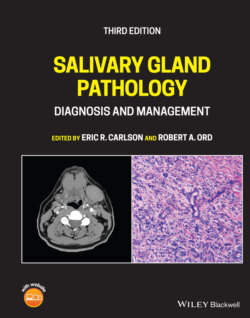Читать книгу Salivary Gland Pathology - Группа авторов - Страница 90
MUCOUS ESCAPE PHENOMENA
ОглавлениеThe mucous escape phenomenon most commonly results from obstruction in the sublingual gland, resulting in a backup of salivary secretions (see Chapter 4). Ductal obstruction may be caused by calculi, stricture from prior infection or trauma. The chronic dilatation of the duct and accumulation of fluid produces a cystic mass by CT, MRI, and US. The simple ranula remains in the sublingual space and typically presents with a unilocular, well‐demarcated and homogenous structure unless complicated by hemorrhage or infection. The walls may enhance slightly if a ranula remains contained above the mylohyoid muscle. It may rupture into the surrounding tissues and extravasate along a path of least resistance and extend inferiorly into the submandibular space or posteriorly into the parapharyngeal space under which circumstances it is termed a plunging ranula (see Chapter 4). The non‐plunging ranula has a dilated ovoid configuration on axial images, but when it herniates into the submandibular space the dilated space shrinks into a tail‐like configuration in the sublingual space. The tail sign is pathognomonic for ranulae and may be seen in both simple and plunging types. The ranula can usually be differentiated from a hemangioma and lymphangioma by its lack of internal architecture (unless complicated). The ranulas are typically homogenous internally with well‐defined margins, unless infected or hemorrhagic, follow fluid density on CT (isodense to simple fluid) and intensity on MRI (low on T1 and high on T2). Both simple and plunging ranulae have these characteristics. The plunging component may be in the parapharyngeal space if the lesion plunges posterior to the mylohyoid muscle or in the anterior submandibular space if it plunges through the anterior and posterior portions of the mylohyoid muscle or through a defect in the muscle. Involvement of the parapharyngeal space and the submandibular space results in a large cystic mass termed “giant ranula” and may mimic a cystic hygroma (Cholankeril and Scioscia 1993; Kurabayashi et al. 2000; Macdonald et al. 2003; Makariou et al. 2003).
